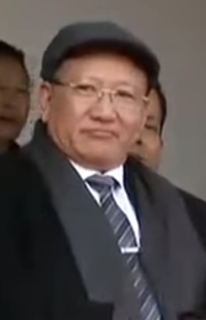Zeme Naga may refer to:
Zeme Naga may refer to:

Nagaland is a landlocked state in the northeastern region of India. It is bordered by the Indian states of Arunachal Pradesh to the north, Assam to the west, Manipur to the south and the Sagaing Region of Myanmar to the east. Its capital city is Kohima and its largest city is Dimapur. The state has an area of 16,579 square kilometres (6,401 sq mi) with a population of 1,980,602 as per the 2011 Census of India, making it one of the smallest states in India.
Peren (Pron:/ˈpɛɹən/) is a small town in the Indian state of Nagaland. It is the district headquarters of the Peren District. Zeme Nagas are the main inhabitants of Peren.

Taditui Rangkau Zeliang is an Indian politician of who served twice as the Chief Minister of Nagaland, a state in India, from May 2014 to February 2017 and from July 2017 to March 2018. A leader of the Naga People's Front, T.R Zeliang took over the reins as Chief Minister of Nagaland following the shift of Neiphiu Rio to national-level politics. T.R Zeliang previously served as a Member of Parliament, representing Nagaland in the Rajya Sabha, the upper house of the Indian Parliament. Currently, he serves as the Chairman of United Democratic Alliance (Nagaland) and was former leader of the NPF Legislature Party and former Leader of Opposition in Nagaland Legislative Assembly.
The Kuki-Chin–Naga languages are a geographic clustering of languages of the Sino-Tibetan family in James Matisoff's classification used by Ethnologue, which groups it under the non-monophyletic "Tibeto-Burman". Their genealogical relationship both to each other and to the rest of Sino-Tibetan is unresolved, but Matisoff lumps them together as a convenience pending further research.
The Naga languages are a geographic and ethnic grouping of languages under the Kuki-Chin-Naga languages, spoken mostly by Naga peoples.

The Zeme people, also known as the Zeme Nagas are the Naga tribe from North Eastern India. Their villages are mostly spread across Peren district in Nagaland; Tamenglong district, Senapati district in Manipur and Dima Hasao district in Assam.
Maram tribe is one of the tribes that form the Naga tribe of Northeast India. The Marams occupy a large portion of Senapati district of Manipur. They are the only tribe of Nagas who did not consume pork in the past; today, with the advent of Christianity, they have started changing their food habit and now almost 99% of the Marams consume pork. The Marams are known for their rich cultural heritage: traditional attire, folk songs, folktales, musical instruments, and so on. There are more than 30 Maram villages scattered in the geographical expanse generally known as the Maram Area. As per the 2001 census, the Maram Nagas numbered about 37,340 in total. According to UNESCO database on endangered languages, the Maram Language was among the list which amounts to only 37,000 number of speakers. These figures, however, need further corroboration.

The Rongmei are one of the major indigenous communities a part of the Naga tribes of North-East India. The Rongmei Naga are a scheduled tribe under the Constitution of India. The Rongmei have a rich culture, customs and traditions. They share similarity with their kindred tribes of Zeme, Liangmai and Inpui which together are known as Zeliangrong.
Haflong Hindi is the lingua franca of Dima Hasao district of Assam state of India. It is a pidgin that stemmed from Hindi and includes vocabulary from several other languages, such as Assamese, Bengali, Dimasa and Zeme Naga. It is named after Haflong, which is the headquarters of Dima Hasao district.
The Tangkhulic and Tangkhul languages are a group of Sino-Tibetan languages spoken mostly in northeastern Manipur, India. Conventionally classified as "Naga," they are not clearly related to other Naga languages, and are conservatively classified as an independent Tangkhul–Maring branch of Tibeto-Burman, pending further research.
The Zemeic, Zeme, or Zeliangrong languages are a branch of Sino-Tibetan languages spoken mostly in Indian state of Nagaland, Assam and Manipur in northeast India. It may have close relationship with other Naga languages pending further research. The corresponding ethnic group is the Zeliangrong people. There were 63,529 Zeliang-speaking people in India in 2011.
Naga nationalism is an ideology that supports the self-determination of the Naga people in India and Myanmar, and the furtherance of Naga culture.

Rongmei is a Sino-Tibetan language spoken by the Rongmei Naga community in Northeast India. It has been called Songbu and is close to Zeme and Liangmai. The language has been nomenclatured as "Ruangmei" and studied as a First Language paper from class I to X of Board of Secondary Education, Manipur. Ruangmei is studied as a Minor Indian Language (MIL) in Class XI & XII of Council of Higher Secondary Education Manipur (COHSEM).
Zeliangrong people are one of the major indigenous Naga communities living in the tri-junction of Assam, Manipur and Nagaland in India. They are the descendants of Nguiba. The term "Zeliangrong" refers to the Zeme, Liangmai and Rongmei Naga tribes combined. Earlier, the term also covered the Inpui tribe. The descendants of Hoi of Makuilongdi (Makhel) were divided and were made peripheral appendages to three political entities - Manipur, Naga Hills (Nagaland) and the Dima Hasao of Assam. The Zeliangrong may be classified as an ethno-cultural entity. The Zeliangrong belong to the larger Southern Mongoloid population and their language belongs to the Sino-Tibetan family of languages.
Zeme may refer to:

Zeme is a Sino-Tibetan language spoken in northeastern India. It is one of the dialects spoken by the Zeme Naga, the other being Mzieme.
Lianglad is a Sino-Tibetan language spoken by Liangmai Naga community in India. It has been called Kwoireng and is particularly close to Zeme and Rongmei.
Makury, or Makury Naga, is a Naga language of India and Myanmar. Shi (2009:3) and Saul (2005:25) suggest that Makury may be an Ao language.
Central Tibeto-Burman or Central Trans-Himalayan is a proposed branch of the Sino-Tibetan language family proposed by Scott DeLancey (2015) on the basis of shared morphological evidence.